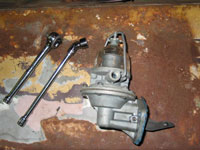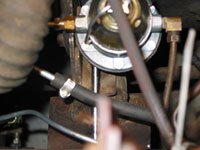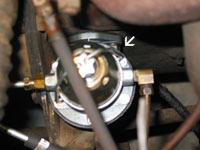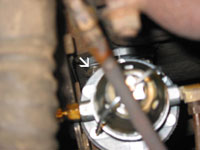|
||||||
 Old pump and the instrument for removal of the number two bolt.  Extension fits between the pump bowl and the frame.  Bolt number one -easy access with a 1/2" wrench.  Bolt number two. |
The CJ2a had received a complete tune-up, but still was stumbling and stalling under acceleration (see Part 6 ). Our thinking was some good gas and “blowing the cobwebs out” by running the engine might help the problem. We tried both, with no real improvement, but neither was the engine running so poorly that we felt the need to find the source of the problem. As these things go, the problem came to us. One Saturday, we had loaded up the rear with fencing tools to do some fence repair – real Farm Jeep work! The fact that the fence wasn’t on the back forty (it was the deer/rabbit fence around Paula’s garden) didn’t stop us from driving around the yard a few times before positioning the Jeep along the fence line to act as anchor for the fence stretcher (a come-along, steel pipe and chain affair). While moving to another stretch point, the motor died and wouldn’t restart. Out of gas? Maybe. Our current gas “gauge” is a wood stick and it showed some gas in the tank. (Note to chief mechanics that we might want to get the real gauge working, although a hammer handle was used as the gauge on the last CJ2a that had worked this farm.) Added gas and with lots of cranking, the motor started. More fence work, more engine idling and more dying. We took a break from the fence work and drove back to the garage for some analysis. We removed the glass bowl on the fuel pump and cleaned the screen. We then checked all the gas lines to make sure they were clean. We put everything back together and cranked the engine. No gas entered the fuel pump bowl. Hmmm… Not having the chief mechanics available, we guessed that maybe we need to “prime the pump.” Observing all the safety standards (we avoided saying “Hey, watch this!”), we poured gas into the carburetor and fired the engine. The engine ran while we fed gas, but no fuel appeared in the bowl. Rule number 28 at Lawson Hill Farm says if it won’t start, drag it around the fields with a chain hooked to a tractor and try the old pull start. It worked! We finished up the fence work and took a victory spin around the meadow. It died on the way to the garage. More pulling with the tractor, but no starting this time. We concluded we had a bad fuel pump. These fuelish things… We fired off an order to Rigid Steel and had the pump in a few days. It couldn’t be simpler; two bolts and two fuel lines to remove. Barry decided he can handle this one himself. He started the project early one Saturday. Remove fuel lines (two minutes) – check. Remove bolt number one (two minutes) – check. Remove bolt number two. Bolt number 2 is nestled between the timing gear cover at the front of the engine and the engine mount underneath. A ½” wrench can be slipped over the head of the bolt, but it can’t move. Time to get out and get under. An off-set wrench can be slipped between the motor mount and timing gear cover, but again, no room to move. The maneuvering to find that it won’t work includes getting covered in 50 year-old grease and dirt in your face and eyes. Gee, it is lunch time already. Early Sunday morning, with a clean face and a fresh attitude, Barry had determined that a wrench won’t work. He had spied a hole in the motor mount that must be for inserting a socket wrench extension. From years of repairing old tractors, Barry has amassed a fairly complete tool box. He assembled his attack weapon; ¼” drive ratchet, extension and a universal fitting, all plugged into a ½” thin-wall socket. Back under the Jeep. The socket was too large to fit through the hole, so he pulled the socket off the end and pushed the extension through the hole. There is no room to maneuver under the Jeep and putting the vehicle on jack stands would have helped. But this was a quick project and he would tough it out. After what seemed like an hour to just get the socket back on the end of the extension, it didn’t work. The universal didn’t allow enough of a bend. Time to ask for some help. But it would have to wait another week. A search of “fuel pump bolt “on WillysTech KnowledgeBase produced 100 messages. Clearly this isn’t a new issue. There were discussions of using a ¼” drive and replacing the bolt with a hex head, but no real details on how to reach the bolt. The next weekend Barry and Evan made a flying trip to Fishers, IN to the first Indiana Flat Fender Gathering. Time to ask for advice. Barry was on target with the ¼” drive, but two universals where required. Never missing an opportunity to buy even more tools, a stop was made on the trip home and a spiffy new ½” socket combined with a ¼” universal seemed the perfect solution. Sunday morning, bright and early, Barry was under the Jeep again. More grease, more dirt, but no luck. Still not enough angle, even with a second universal. Dejected, but determined, he resorted to staring at the pump and chanting “this is way to hard.” No one is quite sure how long the staring and mumbling continued but at some point Barry said “If only I could get a socket in between the pump bowl and the frame right here…” And the extension and socket slipped in and aligned perfectly with the bolt head. Remove bolt number two – one minute. The new pump was back on, bolted down and fuel lines connected in less than 10 minutes. Much of that time was taken up with getting the new gasket aligned. Barry finally placed a small amount of grease on the gasket and got it to stick to the pump housing. He cranked the engine and gas rushed into the fuel bowl and the engine fired right up. Success! A quick spin around the meadow for a test run and things are looking up. The stalling seems to have disappeared, although some choke was required to keep the engine idling. But at least some of our fuel problems have been solved. Evan's notes: |
|||||
|
Farm
Jeep Home | Previous
Part | Next
Part |
||||||

